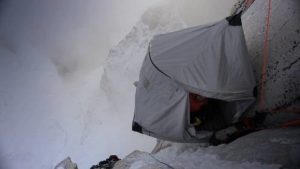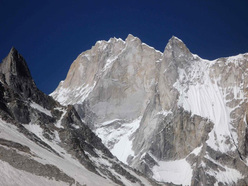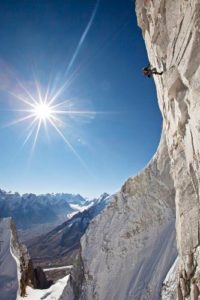
[Golf writer to Your Author: “Why are you writing about a mountain?
Your Author: “Because it’s there.”]
BETHPAGE, NY – The putt that won Tiger Woods his fifth Green Jacket hadn’t even tumbled into the cup before golf media were almost uniformly waxing poetic about “the greatest comeback in sports history!”
Let’s get something perfectly straight: Tiger Woods’s return to athletic prominence is impressive, spectacular and, perhaps, when it comes to golf, an important mile marker in professional golf history. But the over the top reaction of the media and Madison Avenue is a hyperactive combination of catnip meets tequila. Woods himself tried to remind everyone at his post-Masters presser that, “I didn’t get hit by a bus,” as Ben Hogan did in 1949. (Hogan’s injuries were double-fracture of the pelvis, a fractured collarbone, fractured left ankle, chipped ribs and near fatal blood clots. A surgeon was flown from New Orleans by the U.S. Air Force to save his life.)

But even Woods’s rare moment of humility couldn’t pump the breaks on the hyperbolic hagiographic hero worship that erupts from the sporting media every time Woods’s name is on a leader board. After all, as they teach in journalism school, never let common sense get in the way of a good story. Where heroes don’t exist, it is necessary to invent them: it’s good for circulation numbers.
Take that to its nth degree, however, and you get people that just don’t care how detached from reality they sound, like PGA of America CEO Seth Waugh earlier this week:
“Obviously Tiger has the impact, sort of the moon landing. It’s not golf; it’s where were you when, kind of stuff.”
Seth may have just hopped off the first rocket from Pluto with that wild overstatement. So as a wise, reserved jurist might say in response, “With great respect, I must dissent.” Woods’s resurgence is most certainly not anywhere near the “greatest comeback in sports history”: not “arguably,” not “possibly,” not even “perhaps.” It’s not even close.
Renan Ozturk sets the bar far above Woods for miraculous comebacks from injury.
Renan Ozturk is a climber, a “mountaineer” or “alpinist”
as they say in the lingo. A free solo specialist and a talented sketch and paint artist, he caught the eye of our generation’s greatest mountaineer, Conrad Anker. And in 2011, Anker, Ozturk, and snow sports videographer Jimmy Chin all reached the summit of a formerly unclimbed 22,000 foot, near-vertical deathtrap of a mountain in the Himalayas called Meru.
Ozturk summitted Meru (pronounced “MAY-roo”) just five months after tumbling off a cliff, falling 1,000 feet onto his head and fracturing his skull, crushing two neck vertebrae, and severing his vertebral artery. He also had a mild stroke – a “temporary ischmia” – on the way up the mountain
Sorry, Tiger. When matching cards re: comebacks, Ozturk whoops you 5&4.
THE QUEST FOR MERU

High altitude Himalayan climbing is the most dangerous sport in the world, far eclipsing bullfighting, speed racing, alligator wrestling, big wave surfing, and base jumping combined. Above altitude 26,000 feet one enters the “Death Zone,” where the air contains 1/3 less oxygen than at sea level, and where human life cannot be supported after mere days, perhaps even hours depending on the body’s ability to oxygenate blood. Add to that the ever present danger of avalanches, frostbite, falls, hurricane winds, triple-digit wind chills, disease, infection, altitude sickness, and pulmonary edema (fluid in the lungs) and you understand the magnitude of the risk high altitude climbers assume every second of every day on the mountain.
Death is the background noise of their sport, the silent soundtrack of their lives.
Meru is especially difficult and dangerous. Mount Everest was first climbed in 1953 and K2, (considered by many the hardest climb in the world and far more difficult and dangerous than Everest), was first summitted in 1954. But until 2011 Meru, 6,000-7,000 feet shorter than K2 or Everest, had never been conquered.
It was almost like a will-o-the wisp, this mythical place, impossible to get to, the stuff of legends, climbing’s Holy Grail. Deep… DEEP! in northern India at the headwaters of the Ganges, the most sacred river on Earth, dizzyingly soars this mighty spire: a 22,000 foot tall slab, the last 3,000-4,000 feet of which is a sheer vertical, sharp-edged, granite wall called the Shark’s Fin. A real-life stuff of legends, the natives believe it to be the center of the universe, that point where Heaven, Hell, and Earth all meet, a sacred place, haunted by spirits, some benevolent and some evil, in constant conflict with each other.
It’s a staggeringly desolate, this home of the Gods.
60-plus years after Everest, K2, and nearly every other 8,000 meter peak in the world had been climbed, Meru’s reputation of being an impossible climb remained. If you die on Everest they might find your body. If you die on Meru they might find…PARTS…of your body.
Of all the great climbers from every generation, no one had succeeded at standing on the pinnacle. Until 2011, it defeated everyone for all time.
As it is the final examination of the master climber, Meru became the obsession of Conrad Anker, the world’s greatest living mountaineer and America’s proper rejoinder to England’s Sir Chris Bonington. A polestar of a mountaineer by which other climbers set their compasses, Anker is best known for finding the body of George Mallory on Everest. (Mallory’s words echo throughout eternity; even people who know nothing about climbing have heard them: “Why are you climbing Mount Everest? Because it’s there.”)
Anker, however, should rightfully be known for the many difficult first ascents he’s made around the globe, including the east face of Vinson Massif, the highest point in Antarctica. He’s also climbed Everest on a fistful of occasions.
But Meru is the anti-Everest.
“When you want to have a birthday party or a story to tell, you climb Everest,” said veteran mountaineer Wilco van Ruijen in a 2009 interview, and he’s right. Sherpas can carry you and your gear up Everest with relative ease. There are few sections of steeps or technical climbing, and ropes secure you all the way up the mountain, even at the infamous Hillary Step. For around $80,000 U.S., a package dealer will pull you up Mount Everest (with varying degrees of success…).
By contrast, Meru combines Himalayan expedition with ice climbing and big wall climbing. There are no high altitude porters carrying anything for you. You need 200 pounds of gear, food, water, fuel, for each man in the expedition.
“Peaks like that are so difficult that no one even considered [climbing] it for years,” explained famous high altitude climber Alan Arnette, a veteran of expeditions to every continent on the planet. “Meru has everything: snow, ice, and an almost impossible rock with overhanging features, also big wall climbing. You have to be a master of all of these.”
But Anker is just that, and so in 2008 he teamed up with Renan Ozturk and Jimmy Chin in an effort to finally conquer the unconquerable; they were going to try to summit Meru, just the three of them…no sherpas, no huge expedition, no comfortable base camp to retreat to. Just three men against the Mountain of the Gods, microbes in the belly of the beast.
They almost made it.

They got to within 300 feet of the summit, when they had to turn back. With what they had to endure before then, it’s a miracle they’re not dead. They had to hang their tent in mid air 19,000 feet off the ground with ice screws because the climb was so steep and the wall so smooth, they sometimes advanced as little as 100 feet vertical in a day.
Then they got stuck in mid-air for four days by a blizzard.
A blizzard at 20,000 feet is unlike anything you’ve seen: a pure white out, zero visibility, no definition between earth and sky. The world had turned into the inside of a milk bottle.
Avalanches ripped down the rock face with in inches of their tent. Another time, they broke the port-o-ledge and had to rig it with whatever they had handy, (athletic tape and ski poles). And they consumed so much of their food stranded there, Chin quipped that they might have to eat their boots. And sometimes the ice screws holding the tent to the rock face popped and they had to repair them in the raging snow storm.
Imagine that for a moment: hanging on the rock wall, in the middle of the night, with winds screaming a fever pitch, suddenly the ice screws holding the tent pop – PING! – and then the whole tent lurches, teetering on its side. Gear falls everywhere, and you wonder if suddenly, helplessly, you’ll feel the weightlessness of the free fall as you plummet thousands of feet. You’re still there? Thank goodness. Now someone has to go out and fix it in the middle of a 20-degree below zero blizzard.
They retreated back to civilization with a combination of frostbitten appendages and trench foot. Trench foot is when your feet actually start to rot. Chin was in a wheelchair for weeks afterwards. Meanwhile, barely off the mountain, Anker was thinking “Do we go back pre-monsoon or post?”
There’s a saying in climbing: the best climbers have the worst memories. Kind of like golfers…
RENAN FALLS 1,000 FEET ONTO HIS HEAD
When a Slovenian expedition to Meru similarly failed in 2010, the trio planned a return in 2011. But five months before they were slated to leave, tragedy struck.
Chin was filming a snowboarding video at Jackson Hole with Jeremy Jones and Xavier de Le Rue and invited Renan to be a part of it even though Ozturk was not a strong skier. Renan caught and edge and tumbled over a cliff, falling 1,000 feet and landing on his head. When Chin found him, there was a triangle-shaped hole in his skull open to the air. Ozturk had crushed two vertebrae in his neck and severed his vertebral artery.
According to Ozturk’s doctors, 90% of people with any one of these injuries would have been crippled for life; they’d never walk again.And with his vertebral artery severed, Ozturk lost half the blood supply to his brain. He was within one minute of being a vegetable.
Four days after the accident, with his head in a brace and a spider’s web off tubes all over him, he looked at Corrad Anker and said, “I want to try it at high altitude.”
Ozturk had survived something people don’t survive. He’d been given a second chance. And what do you do with a second chance?
You take it.
“For me it was worth the risk. It was something I had to do. For me it was worth the risk of dying,” he said in Chin’s documentary film Meru.
Meru was something to hold on to. It’s sort of like the old saw that the number one killer of elderly people is retirement. If someone has a job to do, they tend to live a bit longer to see it through.
“The way he progressed was almost inhuman,” Chin said, also in the film. Stationary bikes, weights, training, intense physical therapy: whatever was needed Ozturk undertook it with singular focus.
“I can tell that I broke my tibia and fibula in three places after being blown into rock field here in Colorado on a climb in 2017,” admitted Alan Arnette, who also knows a thing or two about recovery from a climbing accident. “It took a full year for me to recover (I was 60, not 31 like Renan) but I was focused on being positive, surrounding myself with supportive and positive people. Not only is it a tough road physically but mentally, there is a retraining required to address your fears. It requires climbing and being with people who understand, have patience and love and support you….I refused to define myself by the event or to blame anyone or play the victim. I set hard, ambitious goals and climbed several 20,000- peaks in Ecuador and Nepal 18 months later.”
BACK TO MERU
Noted snowsports and climbing author Jon Krakauer opined that the idea of Anker bringing Ozturk back to Meru was appallingly dangerous for all three of them, not just Renan. Anker had built his reputation on being the most careful, prepared, and responsible climbers. But here was Anker taking a huge risk, making a gut decision, trusting more that this was the culmination of Renan’s coming back to life, an over-archng sense of purpose, fulfillment, and redemption.
“I can only imagine what was in the back of his mind when he got the full view of Meru when they went back,” Arnette said. “I imagine it was mixture of apprehension and excitement but I bet his overarching emotion was one of gratitude.”
You can also bet that the three of them must have felt like Buckner walking back into Shea, especially Ozturk. He bought the plane ticket without telling his girlfriend.
It was also a return to Samsara, the Buddhist Hell.
Gratitude didn’t last long. This was all business in the highest order of magnitude. Once again they man-hauled hundreds of pounds of tent, gear, and necessities. Once again they got snowed in for days. Dinner was flambéed cheese rind on their pen knives over their little gas stove. When they needed to defecate, they had to stick their keister out the tent flap. You can’t remove your gloves at 20-below zero to clean yourself, because your hand will be frost bitten in the instant. Living at high altitude is dirty and uncomfortable at best, deadly at worst.
And face death they did, especially Renan. Suspended 19,000 feetup, after a particularly hard day, suddenly Renan’s speech was slurred, he collapsed exhaustedly, and his eyes rolled back in his head. Anker was sure Ozturk was having a stroke, but what could he and Chin do? Neither were doctors, and anyway until the weather cleared, they couldn’t move up or down. They were stuck there waiting and freezing. It looked as though the worst of all fears had come to pass.
But the next morning Renan rallied.

Its uncertain whether Ozturk suffered a transient ischemic attack, (a temporary loss of blood flow), or was suffering from altitude sickness due to the rate of their ascent, but much lake Arnette once did descending K2 in 2014, or Mike Thompson did during the 1972 British Annapurna expedition, Ozturk suddenly felt better.
“It was my turn to lead,” he explained.
Two days later, they summitted. Meru had finally been vanquished, and Renan’s comeback was complete. He was one of the first three people to stand 21,850 atop the Shark’s Fin.
TIGER VS. RENAN
Golf is a wonderful metaphor for life, but it is just that: a metaphor. Losing a golf tournament may be the death of a dream, but in climbing, the metaphor is the truth. Death is the background noise of climbing.
With the greatest respect to members of the golf industry and media, let’s remember to keep a proper perspective. Climbing above 8,000 meters into the death zone where if you stay too long, you die of oxygen starvation? Hanging your tent in mid air thousands of feet off the ground for three days while a 20-degree below blizzard howls around you? That’s one step short of a moon landing. Playing golf in greater New York City? That’s just a game.
Yes, both Tiger and Renan’s stories are inspiring most of all because they show that with the advances of modern medicine we can make these severe injuries recoverable. Both stories give people both faith and hope. But Renan truly risked his life for redemption. Tiger only had to work up a good sweat. Tiger had a long road back from a fused back. As he put it in his pre-championship presser, “I had to do more work on managing my game, my body, understanding it, what I can and cannot do, shots that I see I could pull off or better save it for another day…. That’s the fickle nature of having my back fused. Some days I have more range of motion. Some days I don’t. Some days I ache more, and sometimes I don’t. That’s just — there’s more volatility…There’s more days I feel older than my age than I do younger than my age. As you said, sometimes quick turnarounds, weather delays, those are all things that will certainly test it.”
So you see the difference: A weather delay for Woods is a couple hours or an overnight. A weather delay for Ozturk is four days in a blizzard trapped in a tent dangling in mid air while the maelstrom shrieks around him like all the banshees of Ireland. Tiger ate bone in cowboy rib-eye the night before the Masters started and had a choice of Branzino Provencal or Miyazato beef for PGA Championship dinner. Renan ate frozen couscous for a week. Golf tournaments aren’t played in 20-degree below zero weather, 70-below factoring in wind chill. And yes, a fused back is serious major surgery, but it’s not a 1,000 foot tumble off a cliff. And when you double bogey a Himalayan mountain, you may never come back at all.



